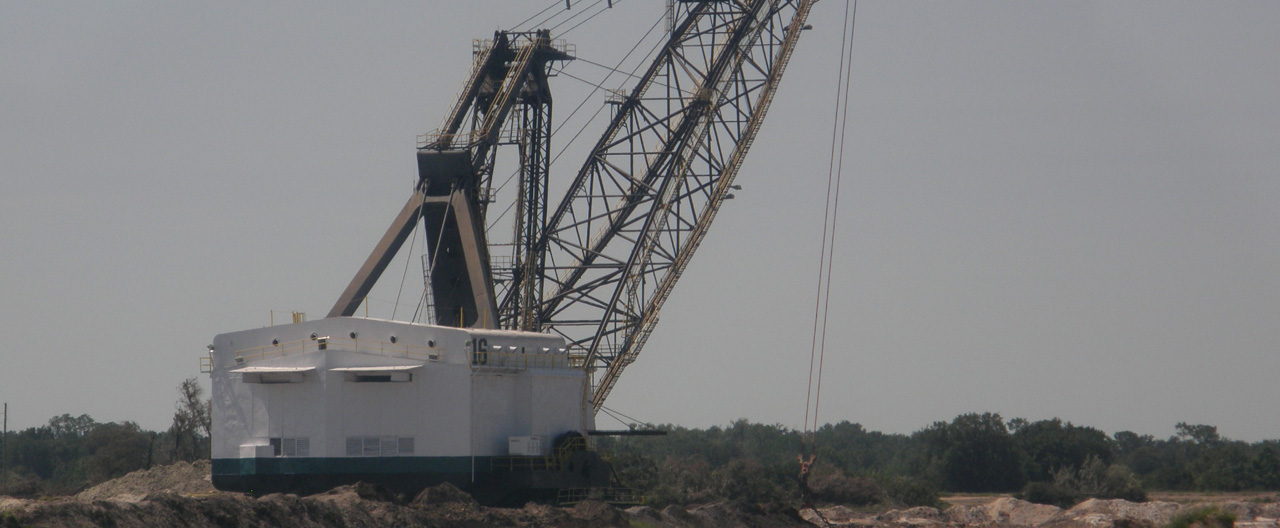Phosphogypsum and the EPA Ban
Phosphogypsum is a by-product of the chemical reaction called the “wet process,” whereby sulfuric acid is reacted with phosphate rock to produce the phosphoric acid needed for fertilizer production. There are approximately five tons of phosphogypsum produced for every ton of phosphoric acid produced.
Phosphogypsum, like natural gypsum, is calcium sulfate, a relatively innocuous material that is used to make things like wallboard. Phosphogypsum, however, is slightly more radioactive than natural gypsum. The radium that is found naturally associated with phosphate rock becomes associated with the phosphogypsum after the rock is reacted with sulfuric acid.
The U.S. EPA prohibits the use of phosphogypsum because of the radioactivity. An exception is made for phosphogypsum with an average concentration of less than 10 pCi/g radium which can be used as an agricultural amendment, but for no other use. Phosphogypsum in north Florida has 10 pCi/g radium. Central Florida phosphogypsum averages 26 pCi/g radium.
America is blessed with abundant, low-cost natural gypsum. There is also an abundance of flue gas desulfurization gypsum produced as a by-product of coal-fired power plants. As a result, the market for the phosphogypsum generated by the chemical processing of phosphate rock has been limited. Traditionally phosphogypsum has been piled on land. This was the least expensive way to deal with the by-product, which in years gone by accumulated at a much slower rate because phosphate chemical processing plants could not run at the capacity they do today. There are currently about 1 billion tons of phosphogypsum stacked in 25 stacks in Florida (22 are in central Florida) and about 30 million new tons are generated each year.
Other areas of the world, however, looked at phosphogypsum as a valuable raw material and developed processes to use it in chemical manufacture and construction materials.
In 1989, stacking of phosphogypsum in the U.S. became a legal necessity when the U.S. Environmental Protection Agency (EPA) banned its use. In 1992, this rule was modified to allow the use of phosphogypsum with an average radium-226 concentration of less than 10 picocuries/gram (pCi/g) for agricultural application as a soil amendment.
Central Florida phosphogypsum ranges from 20-35 pCi/g. Phosphogypsum formed during the chemical processing of north Florida rock, however, has only 5 to 10 pCi/g and is sold to peanut farmers who use it as a soil amendment to provide the calcium needed to form strong peanut shells.
What is 10 pCi/g?
It is customary to refer to the quantity of radioactive material in terms of activity, which is the number of atoms that undergo transformation in the material over a given period of time.
When an atom transforms, it gets rid of excess energy in the form of particles or electromagnetic waves (like gamma rays). Sometimes the atom transforms into another unstable atom and will continue transforming and releasing energy until it is completely stable. The uranium found with the phosphate in Florida’s earth, for instance, transforms through four intermediate elements to radium and then to radon, a gaseous element. It goes through a chain of seven more transformations into unstable elements before reaching stability.
A common unit of activity is the curie, named after Marie and Pierre Curie, who discovered radium. One curie is equal to 37 billion transformations per second. This is a very large amount of activity. To conveniently discuss common amounts of radioactivity – such as that associated with phosphogypsum – we often talk in terms of picocuries (pCi). A picocurie is one trillionth of a curie.
The activity is then related to a given mass or volume of material, such as a liter or a gram, depending on whether the material is liquid, solid or gas.
Thus, 10 pCi/gram denotes the number of transformations occurring per unit of time for a given quantity of material.
For example: If you have 10 pCi/g of radium in a gram of phosphogypsum, less than one radium atom transforms per minute per billion-trillion atoms that make up gypsum, which is almost all calcium sulfate.
This is why the radium is often referred to as a “trace” impurity in the gypsum.
To be “most protective of human health,” however, the EPA has set the 10 pCi/g limit for phosphogypsum use. This limit is based on the dose of radiation the EPA calculated that a person might receive under a series of scenarios in which phosphogypsum could be used.
Most of the scenarios of use fell within EPA acceptable risk limits.
The scenarios upon which the EPA banned widespread phosphogypsum use concerned using it in road construction and agriculture. The scenarios assumed that the road or farm field would be abandoned 100 years later and that a home would be built on the land. The scenarios assumed that the home has no floor to shield against the gamma rays associated with radioactive isotopes in the phosphogypsum. It also assumes that the homeowner lives in the house for 70 years and stays in the house 18 hours a day. Under this scenario the EPA risk assessment predicts the homeowner might have too high a risk of contracting cancer.
That risk is equivalent to a radiation dose of 100 dose units (called millirem) per year beyond the natural background radiation dose of 360 units the average person in the United States gets each year. For comparison, the average two-pack-a-day smoker subjects himself or herself to about 8,000 dose units per year from the inhaled radioactivity in the tobacco leaves.
